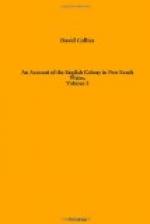In this view, with two musket balls in his gun, he fired at a man who was looking at them from among the trees, and who, being about two hundred yards off, perhaps thought himself secure. One of these balls touched the edge of the bank in a right line for him, the other passed over, but whether it took effect could not be seen. They afterwards landed, intending to bring away the nets, which it was supposed they had in their flight and alarm forgotten. On going upon the bank, previously to ascertain the position of the enemy, he saw several of them running different ways among the trees, apparently with a design of coming round upon them; and, not knowing their force or numbers, Mr. Flinders directed the native and a man who had also landed to return to the boat. But from information since gained from Bong-ree, whose eyes were better than those of Mr. Flinders, he believed they were running to conceal themselves. They had not left their nets.
From the low sandy point where this affair happened, and which obtained the name of Point Skirmish, they proceeded up the opening, which proved to be a river leading to the Glass-House peaks. These peaks stood upon the low flat ground, considerably within the mountains, and, as far as could be judged, had every appearance of being volcanic. That they were so, indeed, was in some measure corroborated by the quantity of pumice stone which was lying at high-water mark upon the eastern shore of the river, on which Mr. Flinders had landed to mark the nature and appearance of the country, not being able from the strength of the ebb tide to proceed far in his boat.
Among the largest and most common trees, there was one differing from any that grew at Port Jackson. The leaves of this tree were of a darkish hue, and bore some resemblance to the pine. The wood, when cut, smelt strongly of turpentine, which exuded in places where the bark had been wounded. The external part of the wood was white, but the body was of a reddish brown, the bark somewhat resembling that of a tree at Port Jackson called the iron bark.
The blue gum, she-oak, and cherry tree of Port Jackson were common here, and also one with the leaves of the gum tree, but with the soft bark of the tea tree. The soil where it grew was very sandy; but, fearing that the natives might surprise them while among the trees, Mr. Flinders did not go far from the beach; it was, however, covered with very tall and not innutritious grass.
Five or six huts, from twelve to fifteen feet in length, were seen standing near each other. They resembled a covered arch-way, rounded at the far end. The roofs, and the manner of securing them, were nearly the same as those which they had seen in Shoal Bay; but these had not any curved entrance to keep out the weather, nor was the hut any smaller in that part than elsewhere, but the sides and roof were equally calculated to shelter the inhabitants from a storm. In one of them was found a small and very light shield, and in another an old net, which had a bag to it, and was knotted and made in the same way as it would have been if made by an European seine maker. It appeared to be intended for a scoop net. There were marks of a large kangaroo having passed, and many traces of dogs were visible on the beach.




